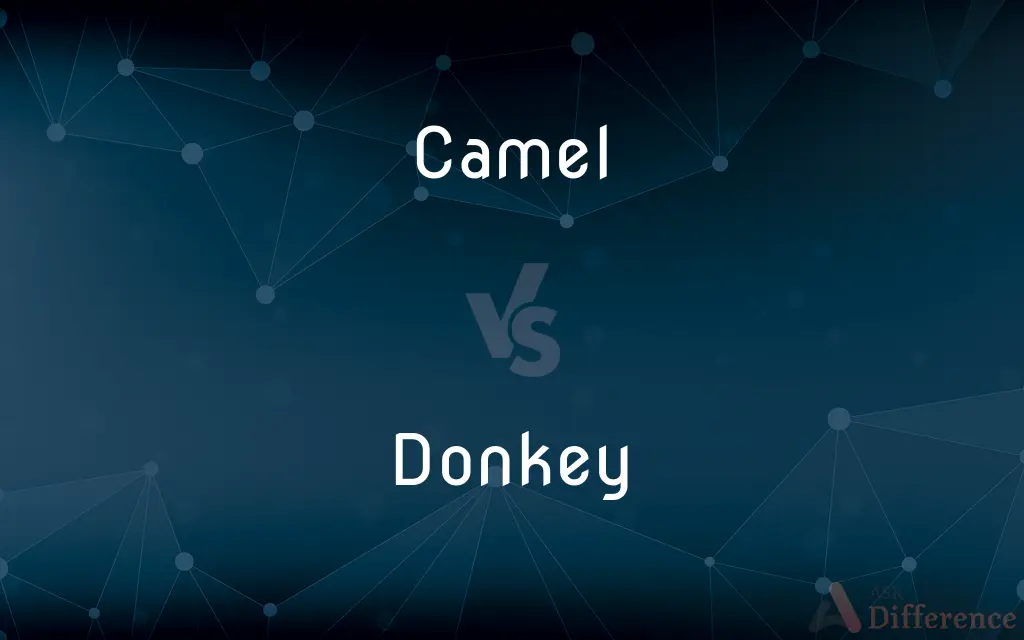Camel vs. Donkey — What's the Difference?
By Tayyaba Rehman — Updated on December 29, 2023
A camel is a large, humpbacked mammal adapted for desert environments, known for its endurance and ability to carry heavy loads. A donkey is a smaller, hardy domesticated animal used for transportation and carrying goods, especially in rough terrains.

Difference Between Camel and Donkey
Table of Contents
ADVERTISEMENT
Key Differences
Camels are large mammals with distinctive humps on their backs, adapted for storing fat and surviving in arid environments. Donkeys are smaller, sturdy animals with long ears and a reputation for endurance, especially in rough terrains.
Camels are primarily found in desert regions, with adaptations like thick eyelashes and humps for water and fat storage. Donkeys are versatile and can thrive in various environments but are commonly used in rural and mountainous areas.
Camels have been domesticated for transportation and carrying heavy loads in desert areas, also providing milk and meat. Donkeys have been used historically for carrying goods, farming tasks, and transportation, known for their reliability and strength.
Camels are known for their endurance and ability to travel long distances without water. Donkeys are recognized for their hardworking nature, patience, and often stubborn temperament.
Camels play a significant role in the cultures of desert-dwelling peoples, symbolizing endurance and survival. Donkeys have been symbols of hard work and perseverance in various cultures, often associated with rural life.
ADVERTISEMENT
Comparison Chart
Size and Physical Traits
Large with humps, adapted for deserts
Smaller, sturdy, long ears
Habitat
Desert regions
Versatile, common in rural and mountainous areas
Uses
Transportation, carrying loads, milk, meat
Carrying goods, farming, transportation
Temperament
Enduring, capable of long distances
Hardworking, patient, sometimes stubborn
Cultural Significance
Symbol of endurance, desert life
Emblem of hard work, rural life
Compare with Definitions
Camel
An animal adapted to arid environments with the ability to store fat in its humps.
The camel's hump is a remarkable adaptation for desert survival.
Donkey
A small, sturdy domesticated animal used for transport and carrying loads.
The farmer used a donkey to carry supplies up the mountain path.
Camel
A domesticated animal used for transportation and carrying loads in desert regions.
Traders loaded their merchandise on camels for the long journey.
Donkey
An animal known for its patience and hardworking nature.
The donkey patiently plodded along the rugged trail.
Camel
A symbol of endurance and resilience in harsh conditions.
The camel has long been revered for its ability to endure the desert heat.
Donkey
A long-eared mammal often used in farming and rural tasks.
Donkeys are essential for work in the fields in many rural areas.
Camel
A source of milk and meat in some cultures.
Camel milk is a staple in many desert communities.
Donkey
A symbol of perseverance and reliability in various cultures.
The donkey is celebrated in folklore for its steadfast nature.
Camel
A camel is an even-toed ungulate in the genus Camelus that bears distinctive fatty deposits known as "humps" on its back. Camels have long been domesticated and, as livestock, they provide food (milk and meat) and textiles (fiber and felt from hair).
Donkey
An animal characterized by its endurance in challenging terrains.
Despite the rough terrain, the donkey carried the load without complaint.
Camel
Either of two chiefly domesticated ruminant mammals of the genus Camelus, the Bactrian camel or the dromedary, having a humped back and long neck, and used in northern Africa, the Middle East, and Asia as a beast of burden and a source of wool, milk, and meat.
Donkey
(Slang) An obstinate person.
Camel
A device used to raise sunken objects, consisting of a hollow structure that is submerged, attached tightly to the object, and pumped free of water. Also called caisson.
Donkey
(Slang) A stupid person.
Camel
(Sports) A spin in figure skating that is performed in an arabesque or modified arabesque position.
Donkey
A domestic animal, Equus asinus asinus, similar to a horse.
Camel
A tan or yellowish brown.
Donkey
A stubborn person.
Camel
A beast of burden, much used in desert areas, of the genus Camelus.
Donkey
A fool.
Camel
A light brownish color, like that of a camel (also called camel brown).
Donkey
(nautical) A small auxiliary engine.
Donkey engine
Camel
Loaded vessels lashed tightly, one on each side of another vessel, and then emptied to reduce the draught of the ship in the middle.
Donkey
A box or chest, especially a toolbox.
Camel
Senseid|en|giraffe}} {{synonym of giraffe
Donkey
(poker slang) A bad poker player.
Camel
Of a light brown color like that of a camel.
Donkey
British sea term for a sailor's storage chest.
Camel
A large ruminant used in Asia and Africa for carrying burdens and for riding. The camel is remarkable for its ability to go a long time without drinking. Its hoofs are small, and situated at the extremities of the toes, and the weight of the animal rests on the callous. The dromedary (Camelus dromedarius) has one bunch on the back, while the Bactrian camel (Camelus Bactrianus) has two. The llama, alpaca, and vicuña, of South America, belong to a related genus (Auchenia).
Donkey
The symbol of the Democratic Party; introduced in cartoons by Thomas Nast in 1874
Camel
A water-tight structure (as a large box or boxes) used to assist a vessel in passing over a shoal or bar or in navigating shallow water. By admitting water, the camel or camels may be sunk and attached beneath or at the sides of a vessel, and when the water is pumped out the vessel is lifted.
Camel
Cud-chewing mammal used as a draft or saddle animal in desert regions
Camel
A large desert-dwelling mammal with one or two humps.
The caravan of camels moved slowly across the desert.
Common Curiosities
How many humps do camels have?
Camels can have one (dromedary) or two (Bactrian) humps.
Can donkeys live in desert areas like camels?
Donkeys are versatile but less adapted to extreme desert conditions than camels.
Can camels swim?
Camels are capable swimmers, though they rarely encounter water in their natural habitat.
What do donkeys eat?
Donkeys are herbivores and eat grass, hay, and grains.
How long can camels go without water?
Camels can go up to two weeks without water under certain conditions.
Do camels really store water in their humps?
No, camel humps store fat, which can be converted to water and energy.
Are donkeys good companions?
Donkeys are known for being loyal and can form strong bonds with humans.
Can donkeys be used for riding?
Yes, donkeys can be ridden, especially by children or smaller adults.
Are camels native to Australia?
No, camels were introduced to Australia and have a large feral population there.
Are donkeys faster than camels?
Generally, camels are faster and can cover longer distances than donkeys.
Can camels tolerate cold weather?
Bactrian camels can tolerate cold, but dromedaries are more suited to hot climates.
Do camels have good endurance?
Yes, camels are renowned for their exceptional endurance, especially in hot climates.
How long do donkeys live?
Donkeys can live for 25 to 30 years, sometimes longer.
What sounds do donkeys make?
Donkeys are known for their distinctive "braying" sound.
Are camels intelligent animals?
Yes, camels are known to be intelligent and can remember routes and locations.
Share Your Discovery

Previous Comparison
Epidermis vs. Epithelium
Next Comparison
Tsunami vs. TornadoAuthor Spotlight
Written by
Tayyaba RehmanTayyaba Rehman is a distinguished writer, currently serving as a primary contributor to askdifference.com. As a researcher in semantics and etymology, Tayyaba's passion for the complexity of languages and their distinctions has found a perfect home on the platform. Tayyaba delves into the intricacies of language, distinguishing between commonly confused words and phrases, thereby providing clarity for readers worldwide.














































